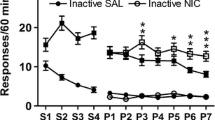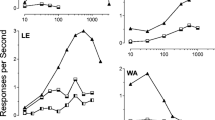Abstract
In experimentally naive rats, nicotine reduced spontaneous locomotor activity in a dose-related manner. After a single pretreatment with nicotine, acute tolerance developed; this was shown by a shift of the dose-response curve, such that the dose of nicotine required to produce a given decrement in activity was multiplied by a factor of about 2.4. In a second experiment, a range of doses of nicotine was found to induce tolerance, but the dose inducing the maximum degree of tolerance was rather critical. The results demonstrated the importance of using a range of pretreatment and challenge doses when assessing tolerance to nicotine. However, frequently repeated doses were not necessary, since tolerance developed when nicotine was administered to rats only once in every 3 days. In terms of tolerance liability in rats, it seems that nicotine is not discriminable from other drugs upon which dependence can be established.
Similar content being viewed by others
References
Federal Trade Commission: Report of “tar” and nicotine content of the smoke of 121 varieties of cigarettes. Washington, D.C., August 1971
Kalant, H., LeBlanc, A. E., Gibbins, R. J.: Tolerance to, and dependence on, some non-opiate psychotropic drugs. Pharmacol. Rev. 23, 135–191 (1971)
LeBlanc, A. E., Kalant, H., Gibbins, R. J., Berman, N. D.: Acquisition and loss of tolerance to ethanol by the rat. J. Pharmacol. exp. Ther. 168, 244–250 (1969)
Lomax, P., Knox, G. V.: The sites and mechanisms of action of drugs affecting thermoregulation, pp. 146–154. In: The Pharmacology of Thermoregulation. E. Schönbaum and P. Lomax, Eds. Basel: Karger 1973
Mattila, M. J., Saarnivaara, L.: Changes in the brain catecholamines after the chronic treatment of rats with nicotine or morphine. Farmaseut. Aikakauslehti. 76, 287–293 (1967)
Morrison, C. F., Stephenson, J. A.: The occurrence of tolerance to a central depressant effect of nicotine. Brit. J. Pharmacol. 46, 151–156 (1972)
Nelsen, J. M., Goldstein, L.: Improvement of performance in an attention task with chronic nicotine treatment in rats. Psychopharmacologia (Berl.) 26, 344–360 (1972)
Rushton, R., Steinberg, H.: Mutual potentiation of amphetamine and amylobarbitone measured by activity in rats. Brit. J. Pharmacol. 21, 295–305 (1963)
Seevers, M. H., Deneau, G. A.: Physiological aspects of tolerance and physical dependence, pp. 565–640. In: Physiological Pharmacology, vol. 1, W. S. Root and F. G. Hofmann, Eds. New York: Academic Press 1963.
Stolerman, I. P., Fink, R., Jarvik, M. E.: Acute and chronic tolerance to nicotine measured by activity in rats. Psychopharmacologia (Berl.) 30, 329–342 (1973)
Westfall, T. C.: Tobacco alkaloids and the release of catecholamines. In: Tobacco Alkaloids and Related Compounds, U.S. von Euler, Ed., pp. 179–201. Oxford: Pergamon 1965
Winer, B. J.: Statistical Principles in Experimental Design. New York: McGraw-Hill 1962
Author information
Authors and Affiliations
Rights and permissions
About this article
Cite this article
Stolerman, I.P., Bunker, P. & Jarvik, M.E. Nicotine tolerance in rats; role of dose and dose interval. Psychopharmacologia 34, 317–324 (1974). https://doi.org/10.1007/BF00422555
Received:
Issue Date:
DOI: https://doi.org/10.1007/BF00422555




